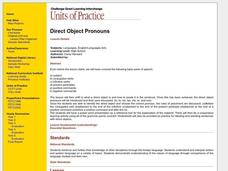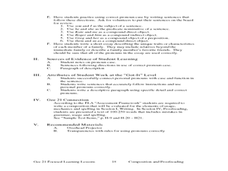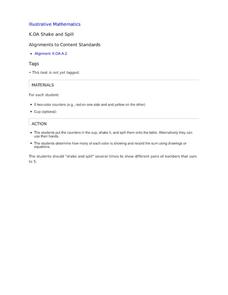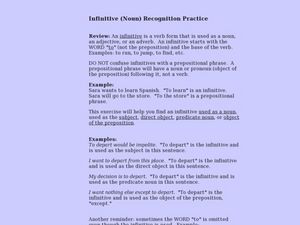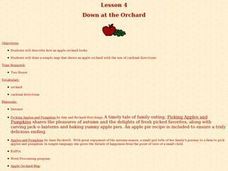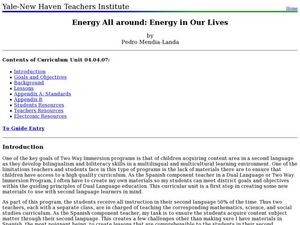Curated OER
Indirect Object- Direct Object Recognition Practice
In this nouns in sentences worksheet, students first read about the difference between direct and indirect objects. Students read ten sentences and write down the indirect and the direct object.
Curated OER
Spanish Sentence Structure
Instruct your class on how to put together a sentence in Spanish. The resource covers the different parts of speech, showing how the Spanish version of each sentence compares with the English version. While there are no procedures...
Curated OER
Indirect Object Pronouns
Directly address the use of the indirect object pronouns with a lesson on how to locate them in sentences and worksheets that provide opportunities for practice using them.
Curated OER
Direct Object Recognition Practice
In this direct object worksheet, young scholars read the definition of a direct object, then find the direct object in a set of 15 sentences. Worksheet contains links to additional activities.
Curated OER
Direct Object Pronouns
Students work together to identify parts of a sentence, and decide where the direct object pronoun should go and what it should replace.
Curated OER
Using Personal Pronouns Correctly
Complete personal pronoun practice activities. Pupils use correct personal pronoun form in sentences the teacher writes on the board. They review the function of a pronoun and the various cases and practice placing personal pronouns by...
Curated OER
Identifying Noun Clauses Worksheet
In this identifying noun clauses worksheet, students identify the type of noun clause in each sentence. Students decide if the clause is a direct object, indirect object, object of the preposition, predicate nominative, subject or...
Curated OER
The Passive Voice in Spanish
The passive voice was mastered by Spanish learners. Your class members can find out all about how to create the passive voice in Spanish using ser, past participles, por, and the impersonal se. Examples are provided for each situation.
Curated OER
Prepositions
After reviewing the different purposes of prepostions and many examples, the class can practice using them in sentences. While little direction is provided in the plan, this is a fantastic resource for teachers looking for a simple...
Nancy Fetzer's Literacy Connections
Expository Paragraph
Upper elementary and middle school writers learn how to craft an expository paragraph by following the six steps detailed in a 48-page instructional guide. Learners learn how to write six different types of informational paragraphs:...
Illustrative Mathematics
Shake and Spill
Entertaining as well as educational, this math activity about decomposing numbers is bound to capture the engagement of young learners. Given a cup and five two-color counters, young mathematicians simply shake and spill the cup,...
August House
The Magic Pot
The Magic Pot by Patricia Coombs is the theme of this multidisciplinary lesson plan. Early readers first take part in a read aloud and grand conversation about the story's details. Then, they get to work practicing their skills in...
Curated OER
Infinitive (Noun) Recognition Practice
In this noun infinitives practice worksheet, students read an informative lesson. Students then respond to 15 questions that require them to identify the infinitives in each sentence and label them as subject, direct object, predicate...
Curated OER
Using Gustar
Expressing that you like something in English is quite different from expressing that you like something in Spanish. Clarify gustar for your class with the information included here. Pupils can read the information on the webpage to find...
Curated OER
The Clause That Refreshes
Students define specialized terminology involving parts of speech. They identify main and subordinate clauses and create complex sentences. They edit and revise writing to incorporate complex sentences and identify parts of speech...
Curated OER
Down at the Orchard
First graders examine what an apple orchard looks like and work with cardinal directions. In this apple orchard and direction lesson plan, 1st graders listen to Anne Rockwell's, Apples and Pumpkins, and Amy and Richard Hutchings',...
Curated OER
Recognizing All Subordinate Clause Uses
In this subordinate clauses practice worksheet, students read an informative lesson. Students then respond to 10 questions that require them to identify subordinate clauses and label them as adjective, adverb, or noun clauses.
Curated OER
Surrealist Games
Students engage in a game of Exquisite Corpse. By looking at a painting by Ren?? Magritte and creating their own Surrealist "room," students further explore the Surrealist idea of placing common objects in unusual locations.
Curated OER
Giving and Taking Directions
Students identify the difference between commands and a declarative sentence. They complete a diagram with verbs, prepositions and numbers. They follow directions using a map and give directions to another location.
Curated OER
Giving and Taking Directions (Middle School)
Students describe the difference between a declarative sentence and a command. They complete a diagram verbs, prepositions and numbers. They follow directions on a map and create directions of their own to another location.
Curated OER
Pilot Takes Off in Kid-Built Plane
Students read a current events news story an answer vocabulary and comprehension questions. In these real world lessons, student use the internet to watch video clips, read blogs, and research pertaining to the planes and pilots. Letter...
Curated OER
Combining Direct and Indirect Object Pronouns
Students combine direct and indirect pronouns in this lesson. They practice with rewriting sentences when a direct and indirect object is present. They create a story using PowerPoint with their new sentences.
Scholastic
Frindle Lesson Plan
"Who says a pen has to be called a pen? Why not call it a frindle?" Inspired by this quote from the award-winning novel written by Andrew Celements, this lesson allows children to invent their own...
Curated OER
Energy All Around: Energy in Our Lives
Young scholars identify the different sources of energy. In this energy lesson, students list different machines and identify the type of energy used to operate them. They create a diagram of a wind turbine and label its parts.




